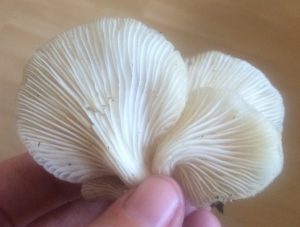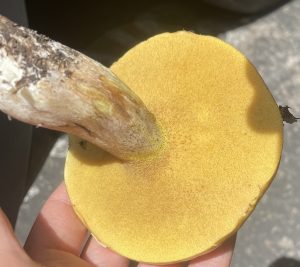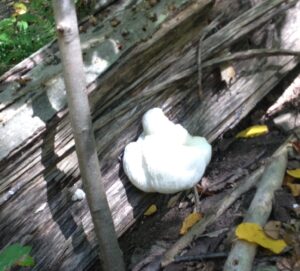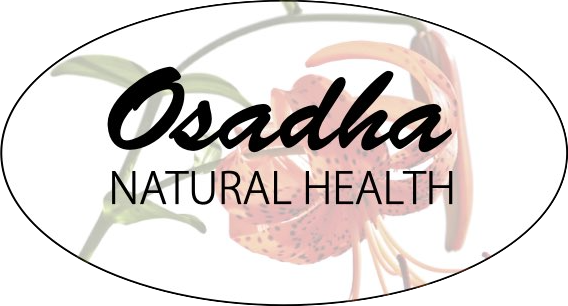There’s a lot out there about mushroom polysaccharides as medicine. To the extent that some folks may believe that polysaccharides are the only significant medicinal bits of a mushroom. But, nope. Mushrooms have a passel of interesting components that make them useful for us humans. Crude extracts of mushrooms , and of course the whole mushrooms, will contain a wealth of nifty bioactive molecules. The fancy marketing term that folks in the cannabis world use describes it well: “full spectrum”. By crude extracts, I mean powdered concentrates, water extracts, tinctures, a combination of the 2 (“double extracts”), and even fancier combination extracts.

Let’s take a a look at what medicinal mushrooms have to offer, beyond their (admittedly very useful) polysaccharides….
Smelly stuff: Volatile organic compounds (VOCs)
VOCs are chemicals that evaporate at room temperature. Many, but not all, have a scent. VOCs encompass a wide range of chemicals that may or may not be natural in origin. In this category are volatile oils produced by plants and fungi. You may more readily recognize the term “essential oil”, which is a VOC and volatile oil that, technically speaking, has been pressed or distilled from a natural source. Another clarification: When you see the word “aromatic” here, it refers to scent rather than to molecular structure. (“Aromatic” can refer to a particular type of molecular ring structure.)
On to “mushromatherapy”… Mushrooms have an aroma. Some have scents resembling things that aren’t even mushrooms; for instance, the aniseed and almond aroma of some Agaricus and Oyster Mushroom species. You folks in the PNW or in the Baltic States may be thinking of the apricot scent of your beloved Chanterelles. On a less pleasant note is the aroma of decaying flesh emitted by Stinkhorn mushrooms. (For more in depth treatment of mushroom aromatics, check out my Mushromatherapy Parts 1 & 2 here or as originally published in Plant Healer Quarterly: Volume 9, Editions 2 and 3.)
Mushroom VOCs do a lot of things for the mushroom. They regulate growth and reproduction; serve as defense molecules against predation or unwanted microbial colonization; communicate messages to nearby fungi, bacteria, plants and animals; and, promote or inhibit the growth of nearby plants depending on whether the plant is a host or a host competitor.
Some of you may be saying “Wait! Don’t mushrooms contain only tiny amounts of volatile oils compared to plants? How can they possibly have an effect on people??”. Well, I’m glad you asked. For one, if you can smell it, then it’s launched a signal directly from the scent receptors in your nose to your brain. More specifically, to your limbic system, involved in emotional regulation, the detection and response to threats (aka. stress), and many other aspects of our behavior. Which, in turn, is one of the significant ways that aromatherapy works.
Along these lines, that rich, earthy smell you may notice if you’re lucky enough to escape to the woods? That’s due in large part to octenol, a small but strongly scented molecule with an 8-carbon backbone. Octenol is a sedating, and breathing it in may be one of the multiple reasons that a walk in the woods can be so calming.
By the way, fungal VOCs aren’t all good for us. “Sick Building Syndrome” is what results when someone spends a lot of time in chronically damp buildings (again, you in the PNW). Such spaces are home to molds, and these molds produce VOCs associated with symptoms ranging from nausea and headache, to itchy skin and irritated airways, to dizziness and fatigue (1).

But back to mushromatherapy…. Hexanal is another 8-carbon compound and it’s a common aromatic in mushrooms (and plants). The scent of hexanal is variously described as fresh, grassy, citrusy, green, fruity or vegetable-like (2). Hexanal can kill pathogenic bacteria such as Salmonella and Listeria (3),suggesting that it may contribute partly to the anti-bacterial effects of edible and medicinal mushrooms. There are many other “C8” compounds in mushrooms, but those aren’t the only scented things that mushrooms produce. Terpenoid compounds are the most common class of scented molecules produced by plants and are also common in mushrooms. For example, D – limonene with its citrusy scent, alpha-pinene with its piney scent, and terpinene with its woody/citrusy scent are commonly found aromatics in medicinal mushrooms and may contribute to their anti-inflammatory, anti-microbial and many other actions of medicinal mushrooms.
A cool factoid: In some cases, a mushroom’s aroma is produced at least in part by someone other than the mushroom (4). Truffles are an example…their valued and distinctive scent comes from Truffle endophytes, microbes that live within the mushroom’s tissues. In other cases, an aromatic molecule may be derived from the mushroom’s host. In distilling Aspen Bracket (Phellinius tremulae), there’s a whiff of wintergreen. The mushroom may be picking up at least some of this from its host, given that Aspen trees contain methyl salicylate and compounds related to methyl-benzoate (5), that are responsible for the wintergreen scent.
Technically speaking, terpenes and their derivatives are polymers of a chemical unit called an isoprene. Isoprene is made by fungi, plants, and animals and, by itself, has neither color nor scent. The number of isoprene units contained and, as mentioned, the types of chemical modifications determine the properties of a particular terpene.
Monoterpenes are the smallest type of terpene, made of just 2 isoprenes as the backbone. (Yes, the “mono” part makes it confusing. Two isoprenes make one terpene “unit”.) As aromatherapists know, monoterpenes make up a huge proportion of plant aromatics. D – Limonene, mentioned earlier, is a monoterpene and is found in Artist’s Conk (Ganoderma applanatum), Red Belted Conk (Fomitopsis spp), and many other medicinal mushrooms. D – Limonene (and a slew of other monoterpenes) has broad anti-fungal activity, which may help protect the mushroom producing it from colonization by other fungi. And may contribute at least in part to the anti-fungal effects that these mushrooms have for us.
Sesquiterpenes are the next size up, with 3 isoprene units. (“Sesqui” means one and a half, reflecting that these terpenoids have 1 and a half terpene units.) Aroma-nerds may be aware of chamazulene and bisobolol, 2 sequiterpenes in German Chamomile with strong anti-inflammatory effects. that Sesquiterpenes are relatively common aromatic constituents of plants and fungi. Bisabolol and Chamazulene from German Chamomile is an example of a sesquiterpene (more properly, a “sesquiterpene alcohol”). Chamazulene is another in Chamomile and is Many sesquiterpenes have anti-inflammatory activity.
Sesquiterpenes are (like many bioactive compounds) better characterized in plants than in fungi. That said, a passel of sesquiterpenes have been found in Enoki Mushrooms (Flammulina velutipes) and are being investigated for their anti-oxidant, anti-bacterial, anti-tumor activities (7), which are known medicinal actions of Enoki mushrooms. If you’ve harvested Saffron Milky Cap (one of the Lactarious deliciousus group), the wild blue/green staining that develops on these lovely orangey mushrooms is due to a class of sesquiterpenes so far found only in Lactarius species. Likely, the more mushroom species examined, the more novel sesquiterpenes will be found.

Diterpenes & Triterpenes
Moving on, diterpenes have 4 isoprene units (2 terpene units). These larger terpenes aren’t generally volatile like mono- and sesquiterpenes. Meaning, they don’t have a scent, or much of one, at ambient temperature. Lion’s Mane (Hericium erinaceus), an awesome edible and medicinal mushroom, has erinacine A, a diterpene that inhibits drug resistant strains of Staphylococcus aureus (ie. MRSA) that cause dangerous opportunistic infections (7). While I’m not really a fan of “drugifying” our botanicals, this is a significant observation as current antibiotics become less and less effective. Erinacine A also stimulates the production of nerve growth factor (NGF), at least in cultured cells (6) raising the possiblity that this is part of the mushroom’s multiple benefits to the nervous system, including the ability to regenerate nerves in vivo. Along these lines, the Bitter Tooth mushroom (Sarcodon scabrosus) also synthesizes diterpenes with a nerve-related action. Namely, they cooperate with NGF to stimulate neurite outgrowth from a nerve cell lines in culture (6). (Neurites are projections on nerve cells that function in transmitting signals from one nerve cell to the next.)
The largest terpenes are the triterpenes (6 isoprenes/3 terpene units). Triterpenes dubbed “ganoderic acids” in Reishi (Ganoderma lucidum) are a major part of this revered mushroom’s pleiotropic health benefits for us. An example are the multitude of triterpenes in Reishi, the ganoderic acids, that are relatively well studied contributors to the pleiotropic health benefits of this revered medicinal mushroom. In terms of extraction, triterpenes are alcohol-soluble (while the mushroom polysaccharides mainly come out in water). Thus, a double extract that is both tincture and decoction will give you triterpenes and polysaccharides. Reishi triterpenes have been a topic of study since the time when hair bands were popular. Some Reishi triterpenes inhibit HIV (8) and dengue virus replication (9) in lab studies by disrupting the activity of viral enzymes. Some play a significant role in the mushrooms liver- and kidney-protective activity (10). Reishi triterpenes also reduce blood pressure and influence blood lipid levels in preclinical studies and in people (11).
Triterpenes are made by many other well-known mushrooms, including Chaga (Inonotus obliquus), Fu Ling (Poria cocos), and Oyster Mushroom (Pleurotus ostreatus).
Terpenes as a class usually have low solubility in water. Instead, they come out with extraction in alcohol or fat. This means that you won’t have many of them in your mushroom decoction but you will have them in your tincture. (Double extracts!)
Bioactive Proteins and Peptides
Peptides and proteins and are polymers of amino acids. Peptides are smaller and proteins are larger. Bioactive peptides and proteins have critical roles throughout the lifecycle of a mushroom: Sporulation, cell division, growth, defense, communication, and more. Some have enzymatic activity; meaning that they catalyze chemical reactions. Others bind specifically to stuff and either inhibit or promote the activity of whatever it is they’re sticking to. Still others are involved in communication. And, that’s all in the fungus. These bioactive peptides and proteins may also contribute to the effects medicinal mushrooms have on us.
Laccases
Laccases are an interesting type of enzyme. Some laccases function in molecular synthesis, while others break stuff down. A number of fungal laccases break down lignin, a structural component in wood and other plant tissues. This is how mushrooms “eat” plant material, which also is a reason that some fungi, like Aspen Bracket (Phellinus tremulae), that can eat live trees are considered the bane of the forest service. That said, the ability of mushrooms to break down dead or dying trees and other plant matter (leaves, etc), is critical to forest health. This recycles nutrients back into the soil. Also, if fungi (and bacteria) didn’t do this, there’d be an ever accumulating pile of dead vegetation covering much of the planet. Along these lines, Red Belted Conk (various Fomitopsis species) is one of the most important breaker-downers and nutrient recyclers in the forests of western North America.
You’d think laccases would be found largely in mushroom mycelia because this is the part of a mushroom that does the eating. But, laccases are also found in the fruiting body (what most folks consider the “mushroom”). For example, laccases are made in high levels in the fruiting body of Lion’s Mane fruiting body (12); and, this high level of expression has folks considering Lion’s Mane as a possible agent for bioremediation of wastes from the paper pulp industry (13). Laccases also appear to regulate the rate of growth of Lion’s Mane (13), maybe not surprising given that these enzymes are a way that fungi eat. (BTW…Fungi break us down, too. Hence the commercial availability of “mushroom coffins” in which we can be deep-sixed.)

Aside from recycling us back to the soil, mushroom laccases may have some medicinal effects for us people. For instance, King Trumpet Mushrooms (Pleurotus eryngii) and Oyster Mushrooms (Pleurotus ostreatus) produce laccases with anti-viral effects. The King Trumpet laccase inhibited an enzyme, reverse transcriptase, that is critical to HIV replication (14). Though the laccase was active mainly in acidic pH (3 to 5) so the applicability of this in a person….hmmmm. The Oyster Mushroom laccase, when incubated with hepatitis C virus (a human pathogen that can ultimately lead to liver cancer) inhibited the entry of of virus into a hepatoma cell line and into peripheral blood cells in a dish (15). Though the amount of laccase used and the length of time the virus and the laccase needed to be mixed raises the question of whether this is relevant in vivo. The laccase also inhibited HCV replication within the hepatoma cell line when added post-infection, though, again, this was at a high dose of the purified laccase (15). Other mushrooms have laccases with anti-tumor effects in cell culture (16).
Ribosome Inactivating Proteins (RIPs)
RIPs are another bioactive protein found in mushrooms (and elsewhere). By breaking down ribosome structure, many RIPs inhibit the translation of RNA into protein. This may be one way that a mushroom defends itself against invaders…if an incoming pathogen can’t make protein, it will die. Inhibiting translation could also be a way to inhibit tumor cell growth and proliferation, and indeed, some fungal RIPs display anti-tumor activity. But RIPs have multiple other biological effects beyond inhibiting protein production. An Enoki Mushroom RIP, “velutin” from Flammulina velutipes, inhibited HIV reverse transcriptase in vitro (7). Velutin also inhibited 2 enzymes involved in carbohydrate breakdown,? – and ? – glucosidase (7) in accordance with the traditional use of Enoki Mushrooms for diabetes. Another Enoki RIP, flammulin, demonstrated anti-tumor effects in rodents (17).
Lectins
These sticky little buggers don’t have enzymatic activity. Instead they stick to specific carbohydrates, many of which are found on the surface of fungi, various microbes, and plants. They can even stick to carbohydrates in solution. Different lectins stick to different carbohydrates, and this specificity has been exploited in the lab for carbohydrate purification, diagnostic testing and other lab assays.
In a mushrooms, lectins may protect the fungus by being toxic to predators or inhibit their growth. They participate in interspecies recognition, allowing a fungus to identify friend or foe. Some regulate the germination of fungal spores, or mycelial development, or fungal cell wall synthesis. Others may help the fungus set up a symbiotic relationship with a host via interactions with host cells. Still others function in nutrient storage (16).
Lion’s Mane has a lectin that inhibits HIV reverse transcriptase, an enzyme critical for viral replication; stimulates white blood cell proliferation (a necessary step in fighting infections), and inhibits the proliferation of various tumor cell lines (18). Oyster Mushrooms also have lectins with potential anti-tumor effects (19). Other mushroom lectins are anti-inflammatory activity, immunomodulatory or have other activities (16) that may underlie, in part, some of the traditional uses of medicinal mushrooms.
Fungal Immunomodulatory Proteins (FIPs)
FIPs are a diverse group of proteins, structurally speaking. They’re put under the FIP heading based on function. FIPs from different mushrooms, and different FIPs from the same mushroom, have a mind boggling range of effects on the immune system. They induce or reduce the expression of cytokines such as TNF-? , interferons, interleukins and other important signaling molecules that orchestrate a multitude of immune responses…be it activating an acute response to infection, reducing inflammation in the gut, preventing cytokine storm, etc, etc, etc. FIPs stimulate the maturation and/or activity of many types of immune cell, including eosinophils, monophytes, macrophages, dendritic cells, B cells, and various kinds of T cell.
Some FIPS, such as FIP-fve from Enoki mushrooms, reduce allergic responses such as allergic asthma, food allergies, and systemic anaphylaxis in preclinical studies. This same FIP, which is found in relatively high amounts in the Enoki fruiting body, also inhibits replication of one cause of the common cold, respiratory syncytial virus (20). A FIP from Reishi, LZ-8, reduced graft versus host disease in preclinical studies, but could also reverse leukopenia, improve fatty liver disease and improve blood vessel health via anti-inflammatory mechanisms (20).
Back to Turkey Tails, which synthesize a FIP dubbed “TVC” (for “Trametes versicolor”), an immune-stimulating protein that increases the number and activity of multiple types of immune cell (21). A different Turkey Tail FIP, FIP-tvc (confusingly enough), can increase expression of multiple immune-active chemicals called cytokines (TNF-alpha, for example) in cell culture (22).These and other Turkey Tail FIPS may be contributors to the traditional uses of the mushroom and bring up the point that purified mushroom constituents lack the spectrum of activity of a crude extract.
Lion’s Mane mushroom has a FIP, HEP3 for “Hericeum erinaceus protein 3”, that countered colitis in a rodent model, and yet another FIP from Turkey Tails, YZP (“Yun Zhi protein”), did as well (20); and, the mechanism may be via FIP-induced alterations of the gut microbiome make up and metabolism (23). HEP3 also reduced the number and size of tumors in rodent studies (23).
ACE Inhibitors
You may have heard of these as pharm drugs. But mushrooms (and plants) contain natural versions. Button Mushrooms (Agaricus bisporus) — ubiquitous, but under-appreciated medicinally —has water-soluble proteins that inhibit angiotensin converting enzyme (ACE) in vitro (24). ACE inhibitors relax blood vessels, thereby reducing blood pressure, though the pharm version causes a range of side effects. Button mushrooms do actually reduce blood pressure in people (25), and some of this effect may be due to mushroom proteins, though they’re also rich in potassium, which can help counter the effect of salt on blood pressure.
A water-soluble peptide from Maitake mushroom (Grifola frondosa), also has ACE inhibitory activity (27). While this was examined in vitro, the use of proteases to mimic what would happen to the protein during digestion did not reduce it’s activity, suggesting the potential that it may actually do something in vivo (27). Water-soluble peptides from Branched Oyster Mushroom (Pleurotus cornucopiae) that inhibits ACE and reduces blood pressure in hypertensive rats (28). A water extract reduced blood pressure in the rats shortly after oral administration, with the average systolic pressure going from 180 mm Hg down to 130 2 hours later (a huge change). In vitro studies showed that the peptides were resistant to digestion by the proteases they’d encounter in the digestive tract, suggesting that they may be resposnible for or at least contriutor to the antihypertensive effect of the extracts (28).
The prized Matsutake mushroom (Trichloma matsutake) has a tiny ACE-inhibiting peptide (TMP, for “Trichloma matsutake peptide”) that significantly and rapidly lowered systolic pressure in hypertensive rats after oral administration (26). The typical side effect of pharmaceutical ACE inhibitors, a dry cough, was not apparent during the studies. A side note…Button Mushrooms are cheaper, can be cultivated, and are thus easier to obtain than Matsutake.
Shiitake (Lentinula edodes), a mushroom used for centuries for hypertension, is yet another that synthesizes water-soluble ACE-inhibitory peptides (29), and lots of other mushrooms other mushroom species have them as well. To be clear, not all ACE-inhibitory thingies in mushrooms are peptide- or protein based. Case-in-point, Reishi has a triterpene that does it.
Other nifty proteins
I did say that I wasn’t going to talk about polysaccarides. But there’s polysaccharopeptide (PSP) of the aforementioned Turkey Tails — that veritable cornucopia (oh, yes…) of biological response modifiers molecules — that improves survival and quality of life in folks with cancer, hepatitis, cardiovascular disease, and chronic respiratory issues (30). It also reduces chemotherapy side effects (30). The mechanism underlying these various benefits seems to be based largely on broad effects on immune system function. So, yes, a polysaccharide’s involved but it’s linked to a peptide….
Turkey Tails also produce a peptide SPCV (small peptide from Coriolus versicolor), that potently inhibits tumor cell division in culture (31). (Seriously…can’t scientists come up with protein names that are a bit less lame???). SPCF does this even more strongly than the famous Turkey Tail polysaccharide PSK (“polysaccharide Kureha)(31), licensed in Japan for improving disease-free survival time, reducing chemo side effects and improving quality of life in folks with cancer.
OK…that’s enough torture for you for now. If you’re relieved for the break from fungal folklore, you’ll like that the next article gets into more magnificent mushroom molecules! If you are missing the folklore articles, no worries. There is another one coming in the new year.
~~~
Content © Dr. Anna Marija Helt, Osadha Natural Health, LLC. Permission to republish any of the articles or videos in full or in part online or in print must be granted by the author in writing.
The articles and videos on this website for educational purposes only & have not been evaluated by the Food and Drug Administration. This information is not intended to diagnose, treat, cure, or prevent any disease or to substitute for advice from a licensed healthcare provider.
References
- Joshi, SM (2008) The sick building syndrome. Indian J Occup Environ Med. 12(2):61–4. https://www.ncbi.nlm.nih.gov/pmc/articles/PMC2796751/
- The Good Scents Company Information System. http://www.thegoodscentscompany.com/
- Lanciotte, R, et al (2003) Application of hexanal, (E)-2-hexanal, and hexyl acetate to improve the safety of fresh-sliced apples. J Agric Food Chem. 51(10):2958-63. https://www.researchgate.net/publication/10783442_Application_of_Hexanal_E_-2-Hexenal_and_Hexyl_Acetate_To_Improve_the_Safety_of_Fresh-Sliced_Apples
- Hung, R, et al (2015) Fungal volatile organic compounds and their role in ecosystems. Appl Microbiol Biotechnol (2015) 99:3395–3405. https://www.academia.edu/11637513/Fungal_volatile_organic_compounds_and_their_role_in_ecosystems
- Ayer, WA & ER Cruz (1995) 2-Carbomethoxyoxepin: 1-Carbomethoxybenzene 1,2-Oxide and the Biosynthesis of Methyl Salicylate in Phellinus tremulae. J Nat Prod. https://www.semanticscholar.org/paper/2-CARBOMETHOXYOXEPIN-%3A-1-CARBOMETHOXYBENZENE-AND-OF-Ayer-Cruz/482c1a362c127a3a2c75be18977c70e71bcdc3d9
- Duru, ME (2015) Biologically Active Terpenoids from Mushroom origin: A Review. Rec. Nat. Prod. 9:4:456-83. http://www.acgpubs.org/RNP/2015/Volume9/Issue%201/58-RNP-1412-266.pdf
- Tang, C (2016) Golden Needle Mushroom: A Culinary Medicine with Evidenced-Based Biological Activities and Health Promoting Properties. Front. Pharmacol. doi.org/10.3389/fphar.2016.00474. https://www.ncbi.nlm.nih.gov/pmc/articles/PMC5141589/pdf/fphar-07-00474.pdf
- Ma, B (2011) Triterpenoids from the spores of Ganoderma lucidum. N Am J Med Sci. 2011 Nov; 3(11): 495–498. https://www.ncbi.nlm.nih.gov/pmc/articles/PMC3271404/
- Bharadwaj, S (2019) Discovery of Ganoderma lucidum triterpenoids as potential inhibitors against Dengue virus NS2B-NS3 proteas. Scientific Reports. 9:19059. https://www.nature.com/articles/s41598-019-55723-5#:~:text=Ganoderma%20lucidum%20(G.,%2C26%2C27%2C28.&text=However%2C%20triterpenoids%20and%20polysaccharides%20were,pharmacologically%20active%20compounds%20in%20G
- Qiu, Z (219) Preventive and Therapeutic Effect of Ganoderma (Lingzhi) on Liver Injury. Advances in Experimental Medicine and Biology. 1182:217-242 https://www.researchgate.net/publication/337577750_Preventive_and_Therapeutic_Effect_of_Ganoderma_Lingzhi_on_Liver_Injury/link/5eb3b2b745851523bd4996d0/download
- Siwulski, M (2015) Ganoderma lucidum (Curt.: Fr.) Karst. – health-promoting properties. A review. Herba Polonica. 61(3):105-18. https://content.sciendo.com/view/journals/hepo/61/3/article-p105.xml
- Kim, S (2020) Antioxidant Compounds for the Inhibition of Enzymatic Browning by Polyphenol Oxidases in the Fruiting Body Extract of the Edible Mushroom Hericium erinaceus. Foods. 9(7): 951. https://www.ncbi.nlm.nih.gov/pmc/articles/PMC7404559/
- Sokó?, S (2016) Biology, cultivation, and medicinal functions of the mushroom Hericium erinaceum. Acta Mycol. 2015;50(2):1069. https://pdfs.semanticscholar.org/eaad/13f707e0f55987cfb445e0d7b6c1ce0b216f.pdf
- Wang, XH (2006) Appl Microbiol Biotechnol 69(5):521-5. https://pubmed.ncbi.nlm.nih.gov/16075291/
- El-Fakharany, EM (2010) Oyster Mushroom Laccase Inhibits Hepatitis C Virus Entry into Peripheral Blood Cells and Hepatoma Cells. Protein and Peptide Letters.17(8):1031-9. https://www.researchgate.net/publication/41434624_Oyster_Mushroom_Laccase_Inhibits_Hepatitis_C_Virus_Entry_into_Peripheral_Blood_Cells_and_Hepatoma_Cells
- Sánchez, C (2017) Chapter 2 Bioactives from Mushroom and Their Application. Food Bioactives, Extraction and Biotechnology Applications. M. Puri (ed.), DOI 10.1007/978-3-319-51639-4_2. https://www.researchgate.net/publication/315867724_Bioactives_from_Mushroom_and_Their_Application
- Watanabe, Y (1964) Flammulin, an Antitumor Substance. Bull Chem Soc Japan. 37(5):747-50. https://www.journal.csj.jp/doi/pdf/10.1246/bcsj.37.747
- Yi, L (2010) A Novel Lectin with Antiproliferative and HIV-1 Reverse Transcriptase Inhibitory Activities from Dried Fruiting Bodies of the Monkey Head Mushroom Hericium erinaceum. J Biomed Biotech. Article ID 716515. https://www.ncbi.nlm.nih.gov/pmc/articles/PMC2896861/pdf/JBB2010-716515.pdf
- Perduca, M (2020) Structure and properties of the oyster mushroom (Pleurotus ostreatus) lectin. Glycobiol. 30(8):550–62. https://academic.oup.com/glycob/article-abstract/30/8/550/5716261?redirectedFrom=fulltext
- Liu, Y (2020) Current Understanding of the Structure and Function of Fungal Immunomodulatory Proteins. Front Nutr. 7(132). https://www.frontiersin.org/articles/10.3389/fnut.2020.00132/full
- Feng, LI, et al (2010) Purification and characterization of a novel immunomodulatory protein from the medicinal mushroom Trametes versicolor. Science China, Life Sci. 54(4):379-85. https://www.researchgate.net/publication/50272415_Purification_and_characterization_of_a_novel_immunomodulatory_protein_from_the_medicinal_mushroom_Trametes_versicolor
- Li, F (2012) Gene cloning and recombinant expression of a novel fungal immunomodulatory protein from Trametes versicolor. Protein Expr Purif. 82(2):339-44. https://www.researchgate.net/publication/221840242_Gene_cloning_and_recombinant_expression_of_a_novel_fungal_immunomodulatory_protein_from_Trametes_versicolor
- Diling, C (2017) Immunomodulatory Activities of a Fungal Protein Extracted from Hericium erinaceus through Regulating the Gut Microbiota. Front. Immunol. doi.org/10.3389/fimmu.2017.00666. https://www.frontiersin.org/articles/10.3389/fimmu.2017.00666/full
- Lau, C-C (2012) Proteomic Analysis of Antihypertensive Proteins in Edible Mushrooms. J. Agric. Food Chem. 2012, 60:12341?12348. https://pubs.acs.org/doi/10.1021/jf3042159
- Sun, L (2020) A mushroom diet reduced the risk of pregnancy-induced hypertension and macrosomia: a randomized clinical trial. Food & Nutr Res. 64: 445. https://www.ncbi.nlm.nih.gov/pmc/articles/PMC7286351/pdf/FNR-64-4451.pdf
- Geng, Z (2016) A Tricholoma matsutake Peptide with Angiotensin Converting Enzyme Inhibitory and Antioxidative Activities and Antihypertensive Effects in Spontaneously Hypertensive Rats. Sci Rep. 6: Article number: 24130 https://www.nature.com/articles/srep24130
- Choi, HS (2001) Angiotensin I-converting enzyme inhibitor from Grifola frondosa. Food Res Internat. 34(2-3):177-82. https://www.sciencedirect.com/science/article/abs/pii/S0963996900001496
- Jang, J-H (2011) Characterisation of a new antihypertensive angiotensin I-converting enzyme inhibitory peptide from Pleurotus cornucopiae. Food Chem. 127(2):412-8. https://www.researchgate.net/publication/233392901_Characterisation_of_a_new_antihypertensive_angiotensin_I-converting_enzyme_inhibitory_peptide_from_Pleurotus_cornucopiae
- Morales, D (2018) Extraction of bioactive compounds against cardiovascular diseases from Lentinula 2 edodes using a sequential extraction method. Biotechnol Prog. 34(3):746-755. https://digital.csic.es/bitstream/10261/192513/3/ectralentinula.pdf
- Chang, Y (2017) Preclinical and clinical studies of Coriolus versicolor polysaccharopeptide as an immunotherapeutic in China. Discov Med. 23(127):207-219. https://pubmed.ncbi.nlm.nih.gov/28595034/
- Yang, MMP, et al (1992) The Anti-tumor Effect of a Small Polypeptide from Coriolus versicolor (SPCV). Am J Chinese Med. 20(3,4):221-32. https://www.researchgate.net/publication/263982757_The_Anti-tumor_Effect_of_a_Small_Polypeptide_from_Coriolus_versicolor_SPCV
